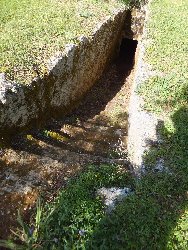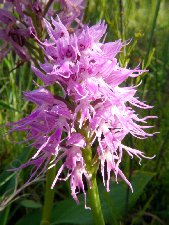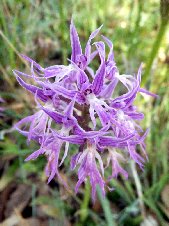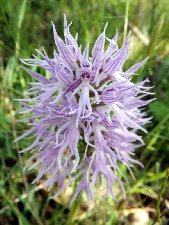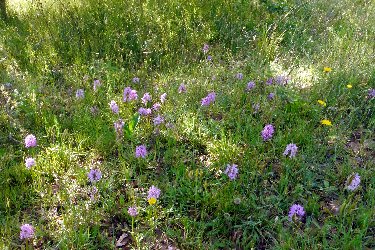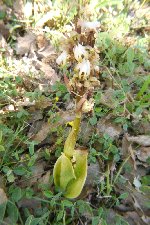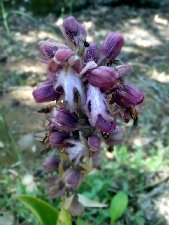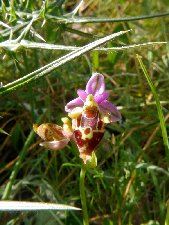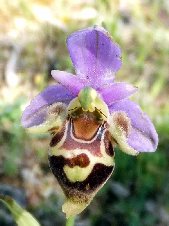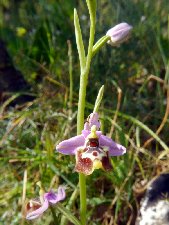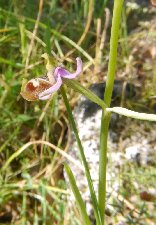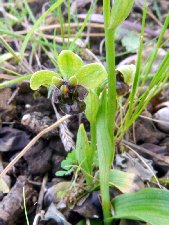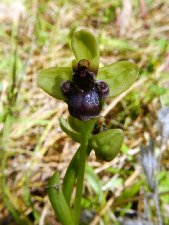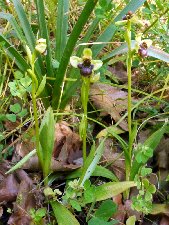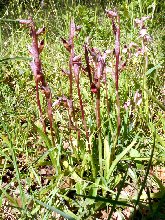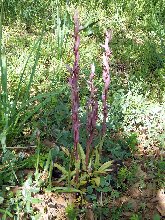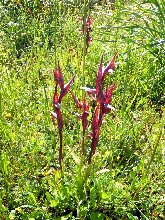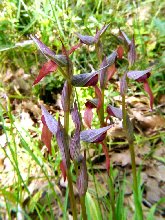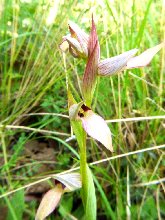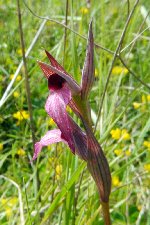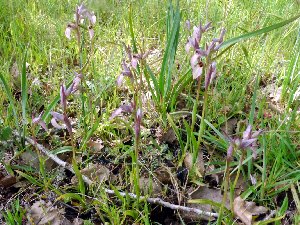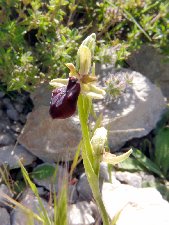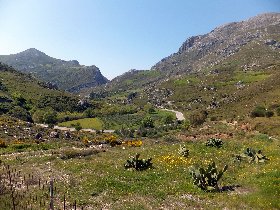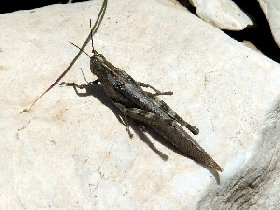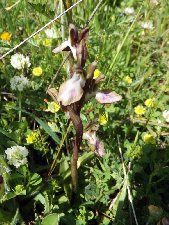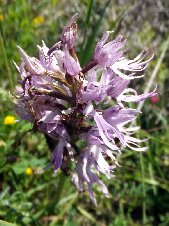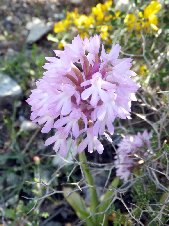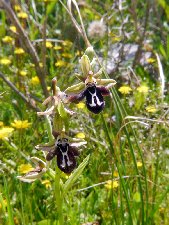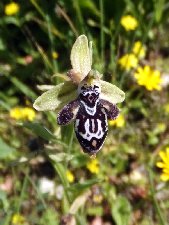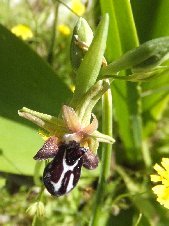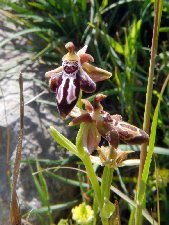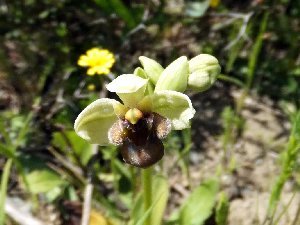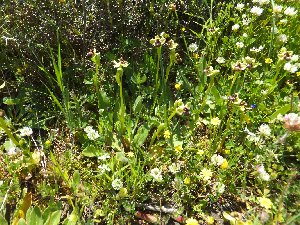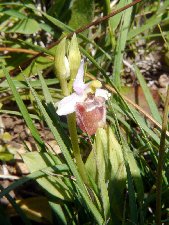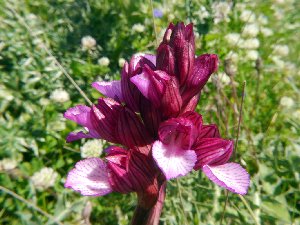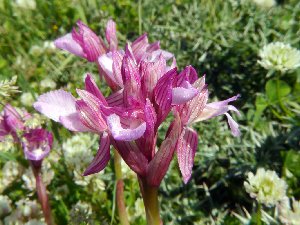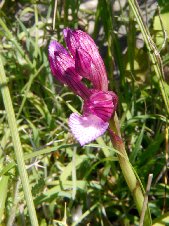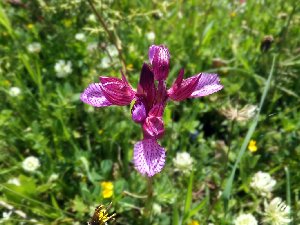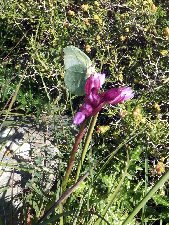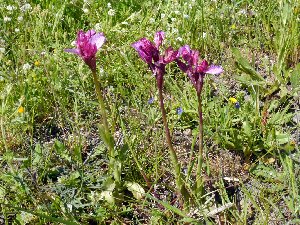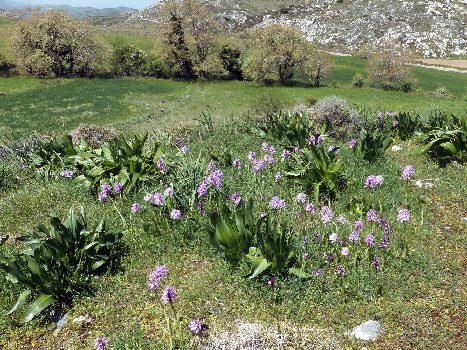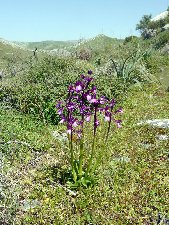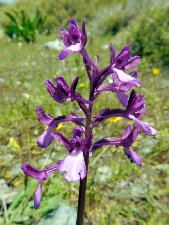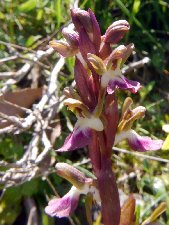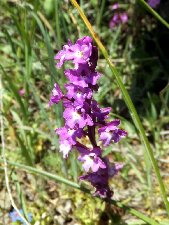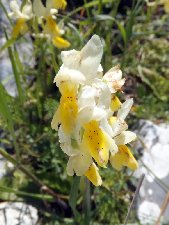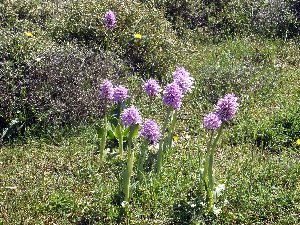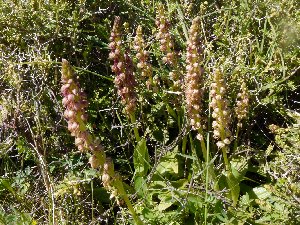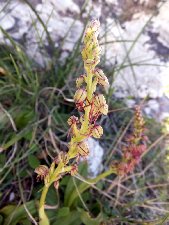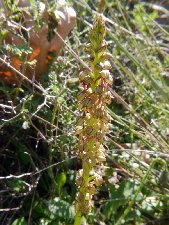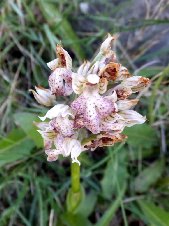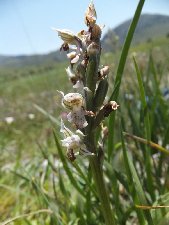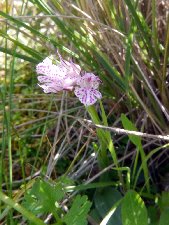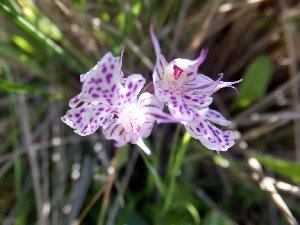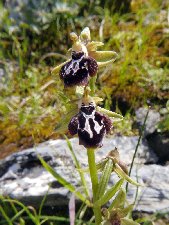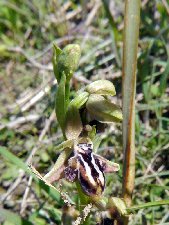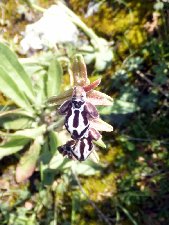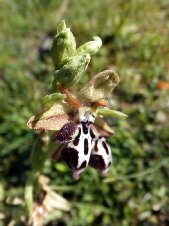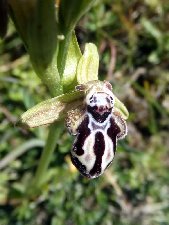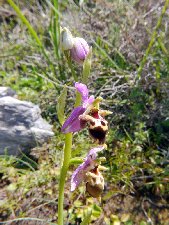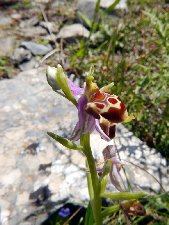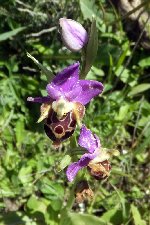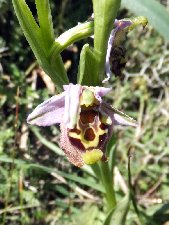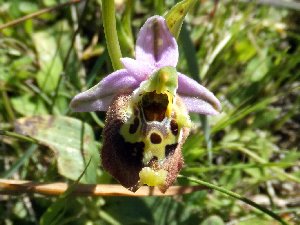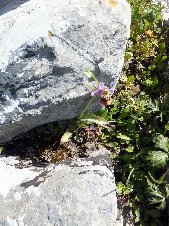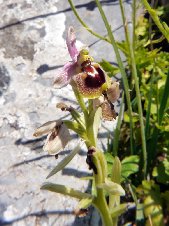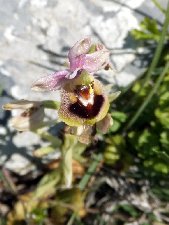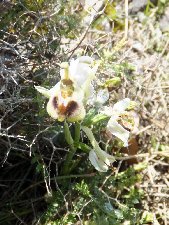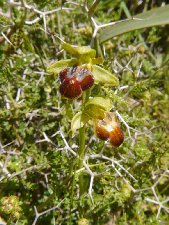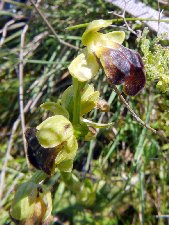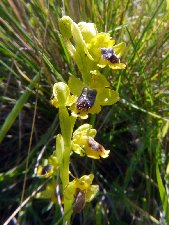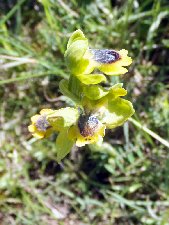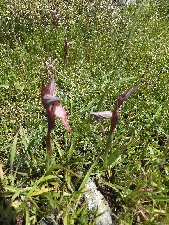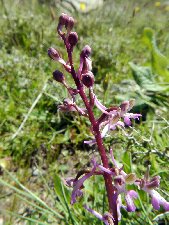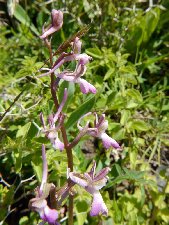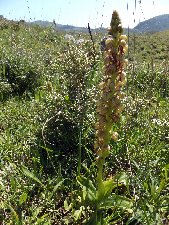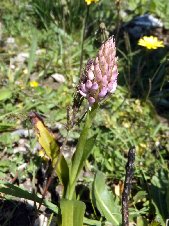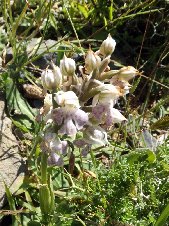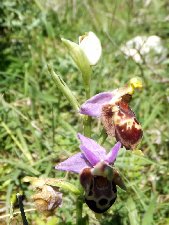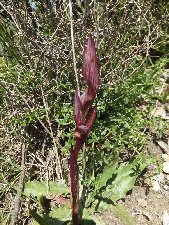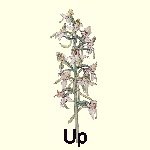|
|
|||||||||||
|
|
|||||||||||
 |
|
Armani Necropolis 9th April 2018 This lies just south of Rethymno, so was the first stop on the quest. 4,500 years ago the Minoan people cut graves deep into the limestone, where they laid their dead in decorated terracotta coffins. This place is worth a visit just for that. Over a hundred of the graves have been opened and you can go down the steps and look inside. There is not only a good orchid flora here, but also quite a few butterflies. The Swallowtails and Tiger Swallowtails are of particular note. The most obvious orchids are the Orchis italica. Their inflorescences tower above the grass and stand out from a distance. One patch had about a hundred in flower. What I noticed about these was the variety of colour, and that the lateral sepals appeared to be unusually long. This is probably an illusion; they are just not curled as so many of species are.
We spotted three Ophrys species at this site, and two were new to me. Op. heldreichii would turn out be the most widespread across the sites we visited. It is easily recognisable from the pointed lip with a pointed yellow tip, and the two curled `horns' either side. The form is quite consistent in colour and shape apart from the lip patterns. Op. episcopalis is also widespread, and though of a similar colour scheme to the heldrichii, the lip is more box-shaped with fine hairs on the sides. The tip of the lip is more like a yellow flap with a wavy edge, and stands erect. More familiar is Op. bombilifera, the Bumblebee Orchid, a common species across the Med and often found in sizable groups due to its vegetative reproduction.
Two species of tongue orchid are noticed; Serapias bergonii and the more familiar S. lingua. The latter is of interest with its possible addition to the British list with the discovery of a 70+ strong colony in Essex during 2017. These have tongues in a range of colours, but the S.bergonii are much more consistent. Outside the archaeological site, where there is a few more graves are more S. lingua, including one with a very long tongue, and Ophrys mammosa. Near Coxare, 9th April 2018 (35.213057 24.471082)
This site gets off to a disappointing start. Firstly there is a pair of rather dull coloured Anacamptis collina and a few rather ratty looking Orchis italica. The next sighting is Anacamptis pyramidalis, so not very exciting for a Brit. A few Serapias lingua dot the path side. Things buck up however when we leave the track, just past the prickly pear field. Here we find three Ophrys species. Most widespread is Op. cretica ssp. cretica identified by the bumps on the lip pointing outwards. Then there is a patch with approximately 40 Op. bombilifera, but the star is a single example of Op. candica. I originally put this down as Op. episcopalis based on the shape of the lip (an inexperience), but a comparison does not bear this out and closer look at the photo reveals the long downward pointing hairs across the lip.
Despite that the stars of the show were the Anacamptis papilionacea. They studded the clover with splashes of bright crimson. Both sub-species list for this area of Crete were present. A. papilionacea ssp. heroica has a large clustered inflorescence, while A. papilionacea ssp. alibertis is a more slender plant with fewer individual flowers. The actual flowers, and in particular the lip patterns, are quite similar.
Spili Hillock 9th April 2018 (35.214519, 24.563961) If there is one place to go to see orchids, at least in this region of Crete, it is the Spili Hillock .. so it is said, but I think we may have seen more species at another nearby site. However, I won't quibble because this is still a great orchid spot. A look on Google Street View while in the trip planning stages showed me that at the coordinates I had for parking there was a huge towering mountain adjacent. Luckily the hillock is on the opposite side and is most definitely a hillock. Access across a stream is by a fallen tree trunk, and once over you can see the orchids on the lower slopes as patches of colour. Close up and you realise there are five, maybe six, species in spitting distance. You can go round the hillock at different levels, or go over the top from different start and end points, but I doubt you will find everything the hillock has to offer. The first species to greet us is Anacamptis boryi, standing out vividly purple. Nearby though, even more magnificent is a bank of Orchis pauciflora. The bright yellow and cream of the large flowers are a total change from the pinks and purples, and create a showy display; the tiny orange dots on the base of the lip seem to be an unnecessary addition to the colour scheme. A. collina is represented by a quite robust plant with bright magenta-pink on the labellum. Without moving many metres we find clusters of O. anthropoporum, all with greenish flowers and bright red lip extremities. This and the previous species mentioned can all be found dotted across the hillock. O. quadripunctata in contrast grows in patches higher up the slopes, but protected by the shrubs. Unlike other sites they all seem to be the same purple colour. O. italica is easy to spot, and can be found in small colonies. They all look to be having a bad-hair day.
Fewer in numbers are the two Neotinea species here, N. lactea and N. tridentata. The former are probably now well past their best, but identifying other flower stalks that have gone over can be done from the green veins on the sepals. The purple pots on the lip are pale and disappointing. N. tridentata has compact flowers making photography more difficult - at least for me! Theses photos do not show them at their best.
The Ophrys genus is well represented on the hillock, and introduces some identification problems. Both Ophrys cretica ssp. cretica and Op. cretica ssp. ariadne seem to be resident. I am basing this on the `bumps' on the sides of the lip; whether they fold close to the lip (cretica), or stick out at an angle (ariadne). Otherwise a macroscopic examination of these two taxon shows them to be virtually identical,yet some regard these as actual separate species. This does have some basis in that they use different pollinators. A more diagnostic approach is the shape of the stigmatic cavity, but that is not apparent on these photographs.
The now familiar Ophrys heldreichii is present across the hill; note the example with rather intense pink sepals. Op. episcopalis is also fairly common, with one looking like it grew out of a rock. There are also some Op. tenthredinifera. This species, whether naturally, accidentally or artificially introduced, has recent flowered in Dorset represented by a single plant. Before we took off for Crete I heard that not even a rosette was to be seen this year. Does this find make up for it? No! On leaving the hill I find a very pale plant with white sepals. A pale flower in bright sunshine is not a good recipe for a good photo unfortunately. Is this the var viridiflora of Davies and Huxley, or what Delforge calls the Cretan taxon?
I find identifying the species of the Ophrys fusca group rather difficult. Example photographs and nice descriptions do not always help me, so I rely on narrowing it down to one or two species to come up with an answer. The two pictured below DO look different, so I have put them down as two species, but the differences could as well be lighting and natural variation. The petals and sepals do show difference, but I am well aware that this is not that diagnostic. Hence I have decided that Ophrys omegafera ssp omegafera and Op. creberimma can be seen on this site.
Site 4, 9th April 2018. (35.21565, 24.56890) There are two sites accessible from this parking spot. One was further along down a gravel track an uncertain distance away, and one in the ground just below the road. As it's getting late and temperatures are still rising I decide on the latter, and will return another day for the gravel track. Actually this site is different to the hillock so holds promise for that, but it is a bit overgrown, most like waste ground, so may not come up with anything. Whilst this site has quite a good orchid flora, the only newbie is Orchis anatolica. Some of these are only just coming into flower. Otherwise the flora is a bit of a mix: Anacamptis pyramidalia still in bud, Orchis anthropoporum including some chunky examples, O. italica, S. lingua., Ophrys sicula, Op. heldreichii, A. papilionacea ssp alibertis in bud, and N. lactea. By now I am too hot, in need of refreshment and my back has reached its limit. This is reflected in the number of photos unsuitable for posting here.
|
|
|
||||||||||||||
